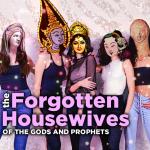
The Kybalion: A Study of the Hermetic Philosophy of Ancient Egypt and Greece.
To label The Kybalion as a Hermetic piece is inaccurate or even blasphemous, depending on how deep your worship goes. Attributed to the “Three Initiates,” this anonymous authorship appears as a mere sly push into mysterious esoterics for effect. However, the general agreement is that William Walker Atkinson was the mind behind these texts.
William Atkinson was an American pioneer of the New Thought movement, penning around 100 oft-revered books within the occult sphere, granting us ample comparisons to point fingers at him. Hence, the Hermetic knowledge in The Kybalion (1908) is blurred into Atkinson’s predefined spiritual contemplations, yet these dubious origins have hardly deterred its accolades. On the contrary, this noncanonical Hermetic work has surpassed genuine Hermetica in popularity.
What is Hermeticism?

Hermeticism is a philosophical and religious system supposedly taught by the legendary Hermes Trismegistus. This prophetic figure is said to be a combination of the Greek god Hermes (Roman’s Mercury) and the Egyptian god Thoth because when those two cultures conversed, both sides agreed that these deities were the same. As if that’s not exciting enough, this holy being also left behind many writings dating from 300 BCE to 1200 CE.
The most famous of these studies are a collection of compatible dialogues titled the Corpus Hermeticum and the immeasurably influential Emerald Tablet. These disciplines covered all the obligatory occult topics, such as anthropology, cosmology, theology, astrology, alchemy, and magic. Moreover, it did so better than anyone, its timeless knowledge laying the foundations for numerous mystical progressions and secret societies to come, including Rosicrucianism, Freemasonry, Thelema, Theosophy, and, of course, the Hermetic Order of the Golden Dawn.
Hence, Kybalion’s use of the Hermetic umbrella to categorise its ideas could suggest a promotional tactic. You automatically snag a sizeable followership of curious eyes, and whatever you say can be sold as the word of the supernatural. Whether this approach was Atkinson’s intention or not is impossible to say, and even more so, irrelevant. For no one can deny that the Kyblaion’s revelations are astounding and potentially life-changing.
The Seven Hermetic Principles

The Kybalion is built around its self-proclaimed Seven Hermetic Principles.
The primary theme of these teachings is for us to refrain from imposing our will on reality and instead harness the higher laws of physics to steer the lower realms. This intellectually stimulating system was far ahead of its time, effortlessly integrating ancient mysticism with contemporary scientific advancements. “God” (referred to as “The All” by Hermes Trismegistus) is depicted as a Living Mind itself, an undiluted immaterial substance from which the operations of the Universe originate. By learning the rules that govern our world and then mastering this way of thinking (a process known as Mental Alchemy), one gains insight into the sacred mechanics and can manipulate them for their benefit.
The Principles are as follows:
1. The Principle of Mentalism
The Principle of Mentalism suggests that reality is a construct of perception, which aligns with certain studies into modern quantum physics (the observer effect). In Hermeticism, this goes further, proposing that the divine collective consciousness (God or Nous) is intertwined with our mental space, and our viewpoints exist within this framework.
2. The Principle of Correspondence
Expanding upon the celebrated Emerald Tablet axiom “As above, so below; as below, so above,” the Principle of Correspondence can have a transformative impact on one’s life. It asserts that the apparent dualities we perceive in the Universe are illusory, as we can simplify everything to a unified energetic substance. Whether spiritual, mental, or physical, all aspects are fundamentally connected on an electron-based level, forming a cohesive whole. Here, every element influences and is influenced by other elements.
3. The Principle of Vibration
This ancient principle is now a scientific fact. Atoms never cease their motion, and according to Hermeticism, these vibrations present different frequencies, creating diverse phenomena.
4. The Principle of Polarity

What appears so obvious when spelt out is that polar opposites are identical, just distinctive degrees on the same spectrum. There is no definitive moment where hot becomes cold or East transforms into West; these shifts occur gradually. This principle can apply to various aspects of life, such as atheism vs theism or conspiracy theories vs mainstream media. Those engaged in these debates often fail to recognise that they operate within interchangeable underlying preprogramming, only differing in perspective. Opposites are always equivalent in nature; the alternating measure is where the illusion of disparity fools us. Consequently, every truth is a half-truth, which reconciles any trouble with paradoxes. It’s an endlessly powerful comprehension to earn.
5. The Principle of Rhythm
Life is a swinging pendulum. The back-forth motion is evident in everything from left-wing/right-wing politics to general social attitudes to our moods. Rise and fall, ebb and flow, up and down; it applies to every layer of existence, big and small. However, we can defeat this seemingly unstable seesaw by utilising Principle 4. This section also introduces the Law of Neutralisation, whereby one can transcend this cosmic rhythm simply by refusing to get involved with it. Awareness is the first step. Thus, when something undesirable stumbles across your day, this is the chapter to recall.
6. The Principle of Cause and Effect
The Principle of Cause and Effect delves into the determinism vs free will debate. As the title suggests, it demonstrates that every cause produces an effect, and every occurrence arises from preceding causes. Nothing transpires coincidentally; instead, events unfold due to an interconnected chain of circumstances. As an illustration, consider the act of rolling a dice. Although it may appear random, it is not. If one could perfectly replicate the conditions—holding the dice in the same manner, throwing it with the same strength and angle on the same surface—the identical number would materialise per each roll.
7. The Principle of Gender
Here, The Kybalion explores the concept of masculine and feminine energies present in all areas of existence. The male essence is associated with initiating energy, while the female essence is seen as the creative force. There is evidence to support this proposal, for example, in the sperm-meets-egg basis of reproduction.
Hermeticism ascribes masculine qualities to “God” (resembling the patriarchal hierarchies found in Abrahamic texts). However, it also acknowledges the feminine aspect of Nature, symbolised by Mother Earth, responsible for creating the material world. More importantly, The Kybalion does not favour one gender over the other, highlighting the importance of both while emphasising that the physical sexes are not synonymous with gender. Sex is regarded as the manifestation of gender, but gender itself is something we all possess within us to a different degree (expanding on Principle 4).
Critical Analysis and Conclusion

While I cannot overstate my appreciation for The Kybalion, I do harbour several objections. Firstly, the text frequently fans the human ego, promoting our species as the pinnacle of creation and equating our mental awareness with the divine. Additionally, The Kybalion expects readers to accept its insights into the Secrets of the Universe as factual, even though the specifics remain speculative.
However, and in fairness, the book confesses that its terminology and conceptual divisions are tools to stimulate further contemplation rather than spoon-feed us precise representations of reality. Moreover, these issues are not exclusive to The Kybalion but plague many other “sacred texts” as well, including the Hermetica itself.
Even with these concerns, nobody would dare deny The Kybalion as an essential piece of esoteric work. When evaluating similar ideologies, this choice stands tall as a superior mystical offering. Despite its assumptions and occasional linguistic limitations, it triumphs by presenting wisdom that collaborates with current scientific and philosophical ideas. Although it may not embody authentic Hermeticism, it surpasses the Corpus Hermeticum in terms of simple instructions and practical guidance. It’s an easy-to-digest yet profoundly self-enhancing system that everyone could (and should!) benefit from.
Accordingly, I enthusiastically recommend The Kybalion to you, whether you’re a serious occult seeker or a casual self-improvement explorer or anywhere in between. Because if you master these concepts, you will liberate yourself from every mental worry and muster a mindset of indestructible invincibility, guaranteed.













